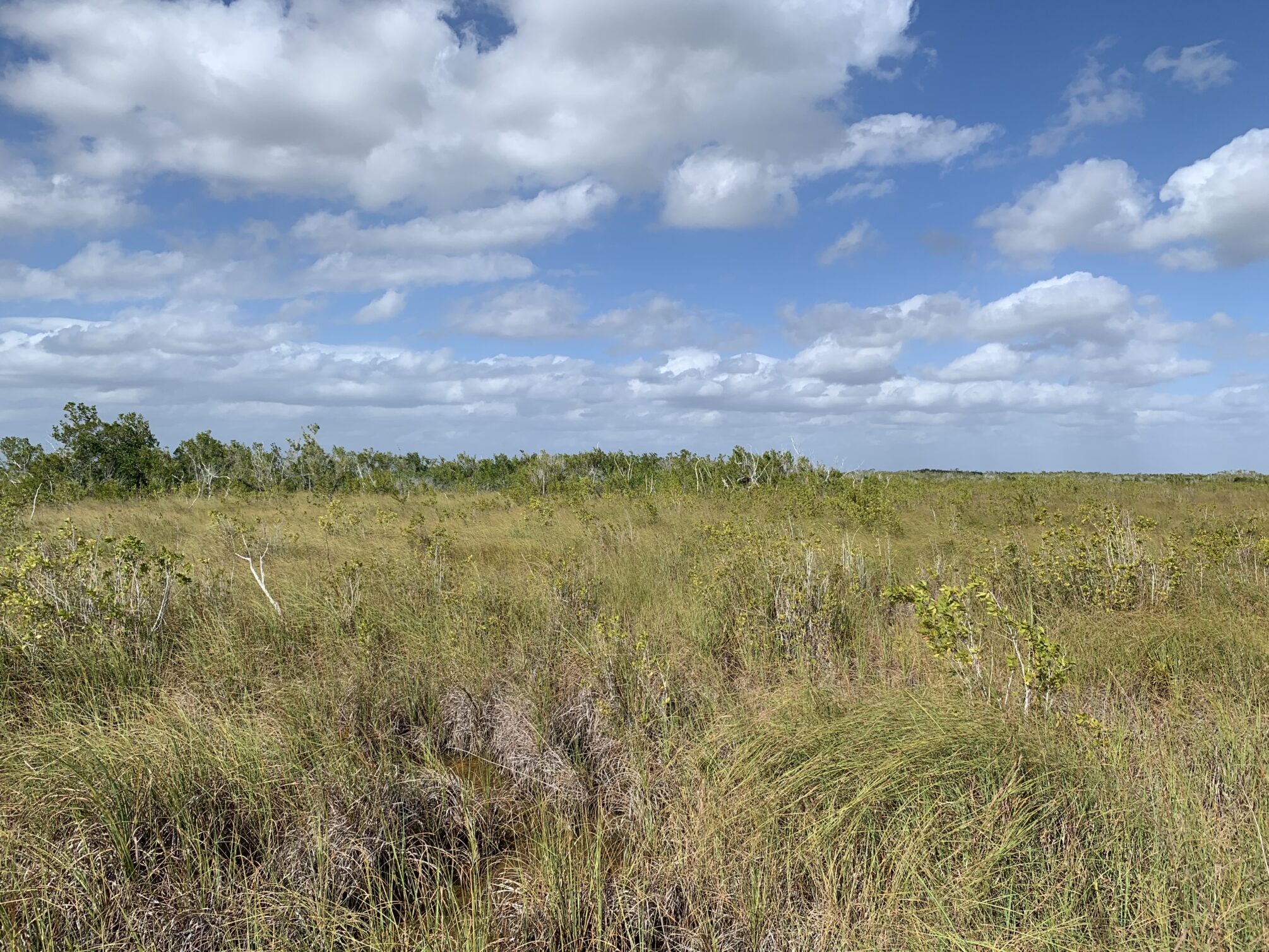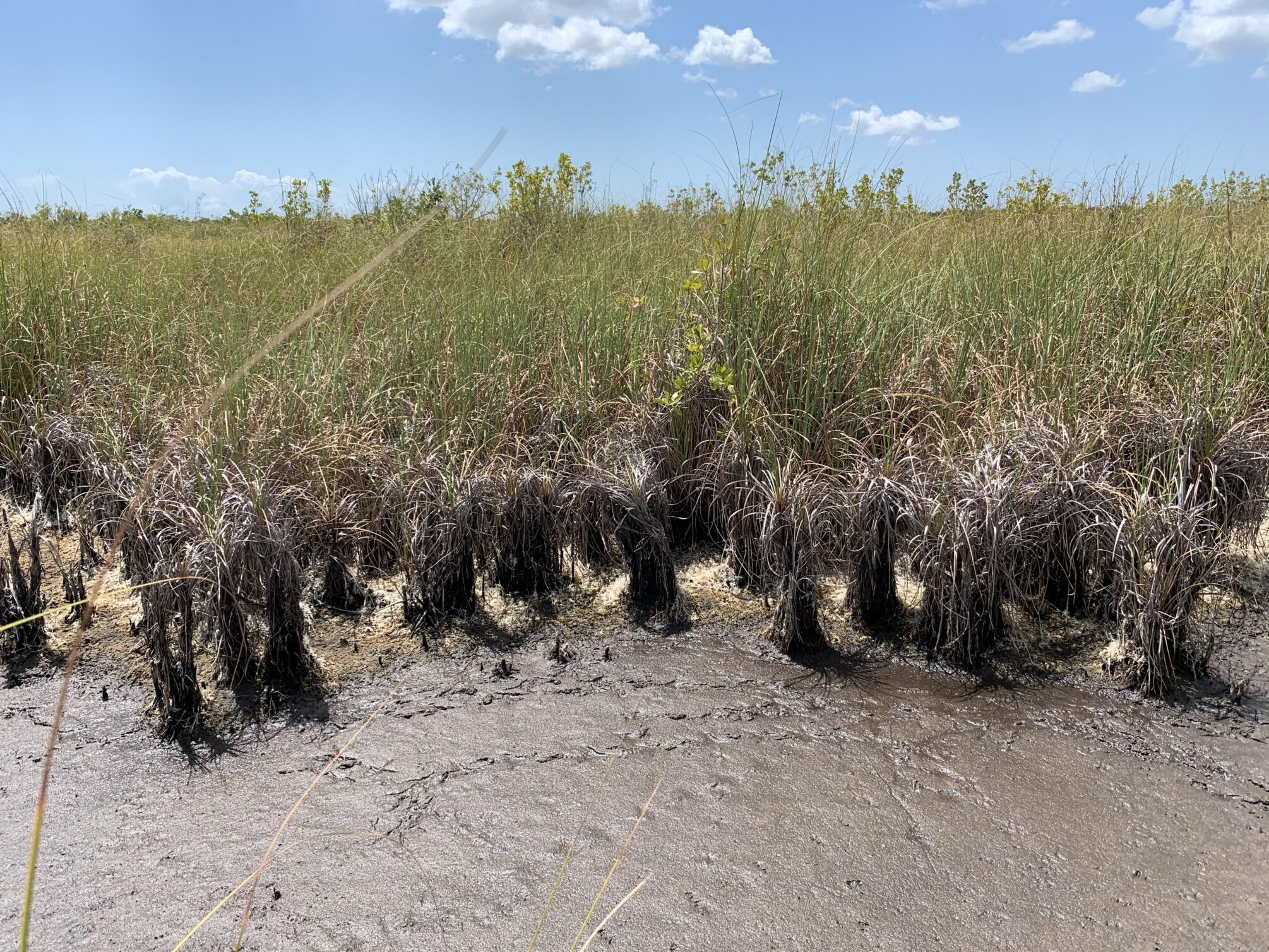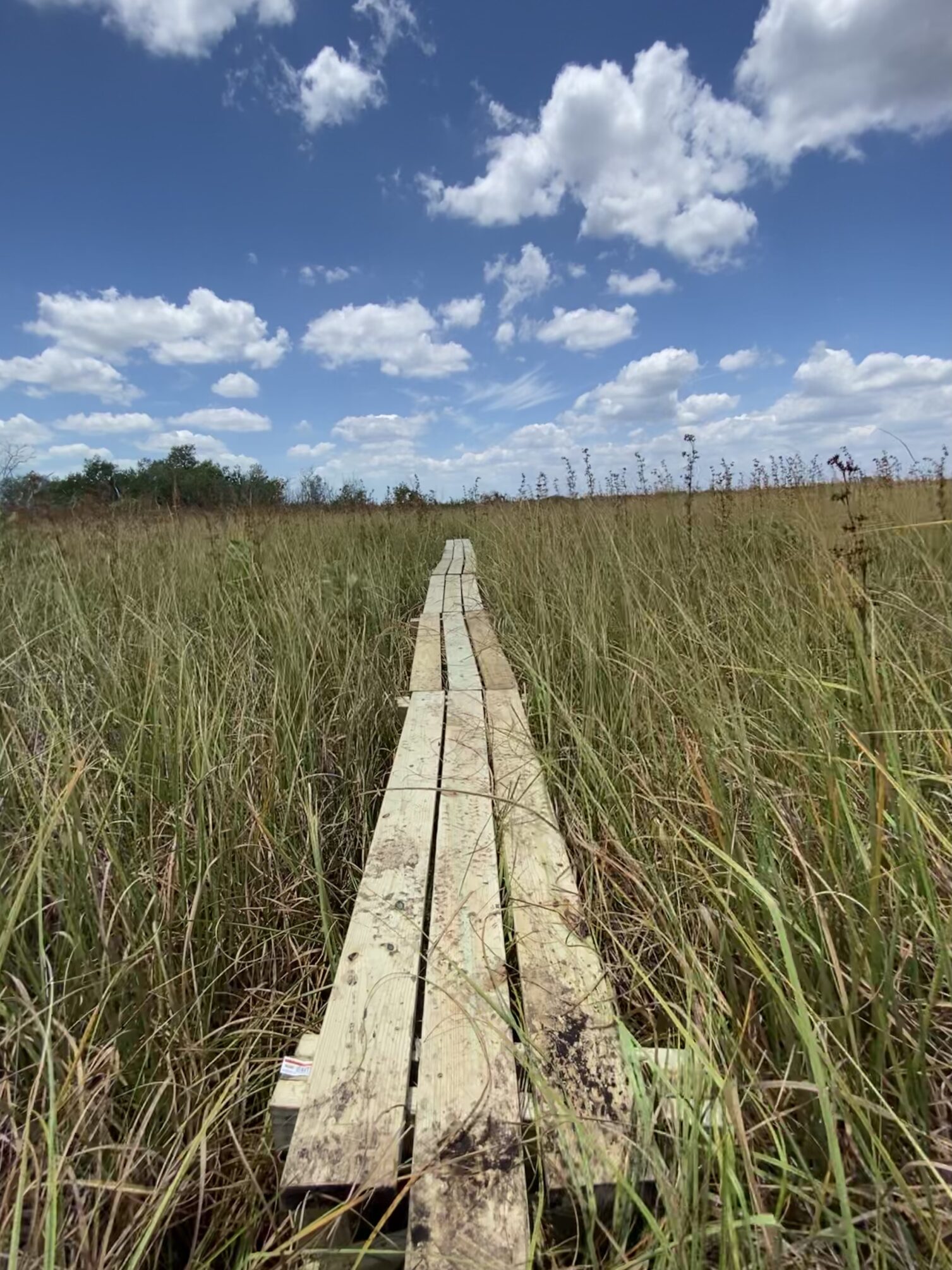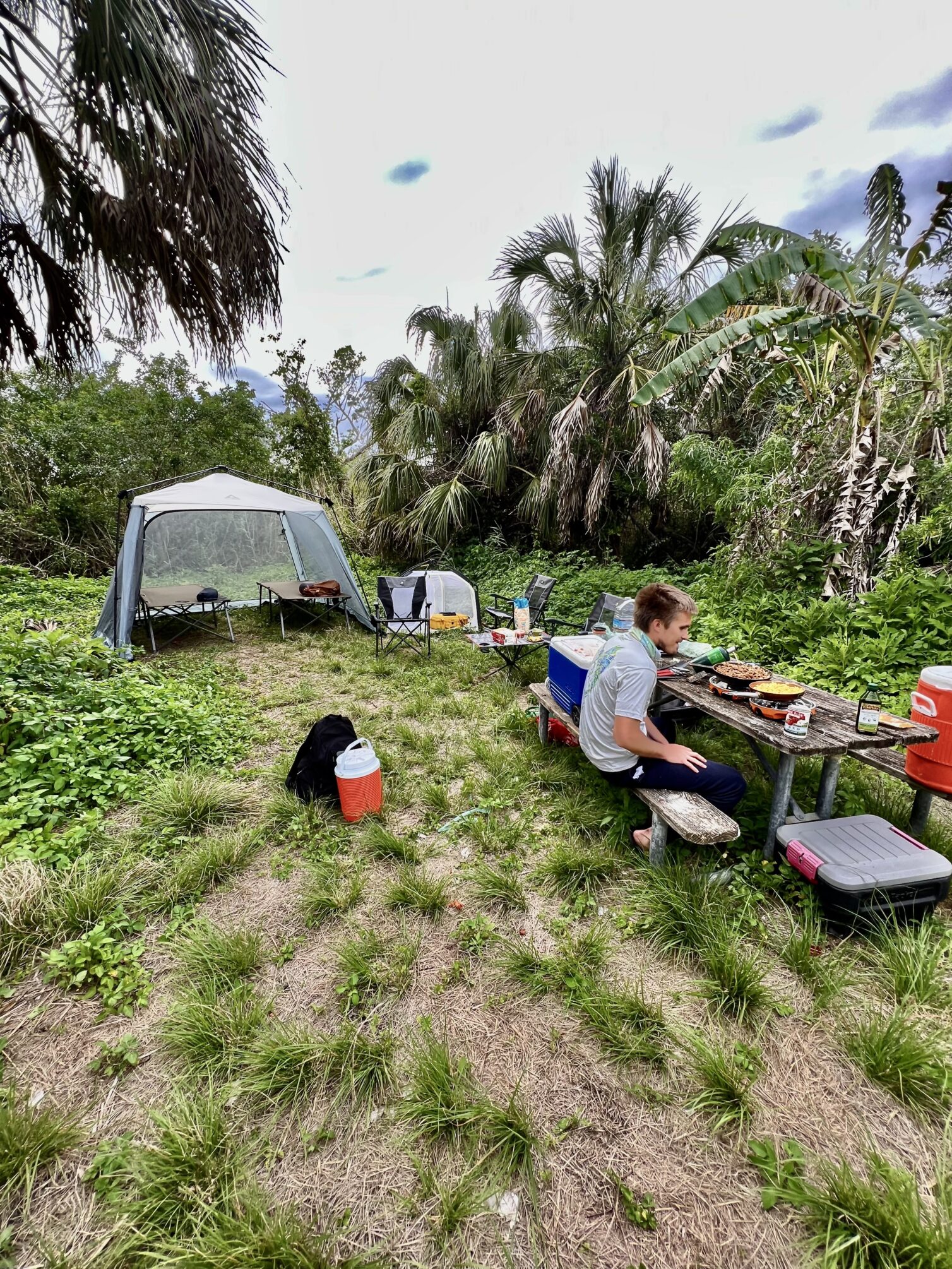
by Mareli Sanchez-Julia, PhD Candidate at Tulane University
The Florida everglades are a mosaic of ecosystems, sewn into patchwork by the hands of freshwater flow, saltwater inputs, soil elevation and plant competition. Climate change impacts like sea level rise and saltwater intrusion, coupled with human alterations to the landscape, are blurring the lines among these ecosystems. Some are expanding their borders as a result, but others are collapsing.
One ecosystem facing collapse is the coastal sawgrass marsh. Sawgrass, Cladium jamaicense, is a freshwater-loving sedge that grows on peat soils. Its densely-packed roots strap in the peat, building and stabilizing the marsh. But diminishing freshwater flow from groundwater and rain plus more saltwater spilling over from the Gulf of Mexico is stressing the sawgrass, weakening its grip on the soil. Peat pedestals form as a result of this stress, where sawgrass roots become exposed to the air in knee high columns above the collapsed peat. Over time, the water will grow too deep for seeds of sawgrass or other plants to establish, and salty expanses of open water take over the marsh.

Measuring sawgrass decline in Everglades National Park
Luke Lamb-Wotton, a PhD candidate in the Troxler Lab at Florida International University (FIU), works at the Florida Coastal Everglades (FCE) LTER site to monitor coastal sawgrass marsh decline. His main project is to map sawgrass vulnerability to saltwater intrusion and peat collapse.
Luke’s ongoing study builds on a previous salt-addition experiment led by FCE scientists, which found that sawgrass productivity sharply declines when salt levels reach 20 parts per thousand (ppt). This is about double the ambient levels of salt in a healthy sawgrass marsh. The results were informed by five key measurements: water depth, salinity, ground elevation, soil variation and sawgrass biomass.
Luke leveraged the salt-addition experiment to develop a vulnerability and hydrologic stress index. He showed that greater hydrologic stress often corresponded with lower sawgrass biomass. In other words, sawgrass did not do well when it was stressed by saltier water during the experiment.
“This [result] really gave us a justification to take it to the park”, says Luke, who is one-year into building sites across Everglades National Park to corroborate the experiment’s results at the landscape scale. The park is particularly interested in what factors cause sawgrass decline because they might guide prevention or restoration efforts. When Luke proposed the expanded experiment, the Everglades National Park agreed to the collaboration.
Expanding the experiment

Once the park was onboard, Luke searched for sites that shared characteristics with the site of the initial salt-addition experiment, such as open-water ponds embedded in the marsh and early signs of soil degradation. In looking back on how his landscape-scale project started, Luke shares that he “spent a month just doing a lot of recon and boating around. I took Edward [an expert FCE researcher for over a decade] further than he’d ever been before”.
Finding sites, however, was only the first step. “You have to build the site before you can actually measure the plants”, says Luke, “and getting lumber out there is the most laborious part”. Luke explains that boardwalks have to be built in order to study ground elevation, one of his five key measurements. They also help to reduce human disturbance to the site by keeping foot traffic away from the soil, allowing for accurate measurements on undisturbed peat. After the boardwalks go in, steel rods are anchored to the bedrock with 45-pound concrete installations, acting as a reference for measuring changes in elevation at each site.
After he set up the infrastructure, Luke had his sites, and some were incredibly remote. He also had his methods, though they were logistically challenging. Yet, he quickly realized that to measure these 5 factors across multiple sites and in remote areas, overnight trips were necessary. “This kind of added a whole new level of logistics and kind of adventure to it. This is in the backcountry. You know, there is no cell service. If you run out of gas, you’re stranded there.”
Prepping for a weekend stay
The typical overnight trip starts at 6am, as Luke drives the hour and a half down Main Park Road to the Flamingo boat launch in Everglades National Park. Once there, he loads the boat with the help of undergraduate assistants and they set off for the weekend. Cruising by 8:30 is a good start to the day.
The crew heads straight to the work site, anticipating a short but intense sampling effort. “We count like 80-90 plants and get all cut up,” says Luke. “After four of five hours of that, it’s mentally hard to maintain, and the morale of the crew begins to fall off, so we call it quits. It’s a balance of staying as long as you can and tolerating the conditions of the marsh”.

After a day’s work, the crew drives the boat about 20 minutes to Cane Patch where they camp for the night. Mosquitos start their feast around dusk, so mosquito shelters and tents are set up before the biting frenzy begins. As day walks into night, the crew makes fajitas and beef tacos to the sound of hooting owls and the occasional water splash of wriggling fish escaping a predator or coming up for air.
This is Luke’s favorite time of the day in the marsh. “Night falls and it gets quiet. It sort of has a different life to it. Spiders come out and they literally build entire webs across the boardwalk, and then you wake up in the morning and they’re gone. It’s a really cool experience just being out there in the wilderness. One night for me sometimes isn’t enough”.
In the morning, the crew rises early to a dew-covered campsite with fog suspended above the still water. After packing up, they head out early for another day of sampling and return to the bustle of Miami by dusk. As of now, Luke has sampled three different sites, which should give sufficient data to map out sawgrass vulnerability to peat collapse across the entire FCE landscape.
Luke’s efforts are essential to the aims of the fourth phase of FCE, which focuses on integrating responses of soil elevation and vegetation to hydrologic regimes. “You see this state shift from vegetated wetland to open water, caused by different presses and pulses operating at different timescales. My work is really at the center of that, trying to connect those different components: the geomorphology, the biome, the vegetation and the hydrology to piece together these feedback loops between them all.” The biggest challenge moving forward is to disentangle the causes of shifts in stable states, and the implication of these shifts for ecosystem function.
While Luke’s work and the work of other FCE scientists is integral to the restoration of Everglades ecosystems, translating the science to policymakers and stakeholders is still a bottleneck. But Luke is hopeful that his work gives those in charge something to work with. “Hydrology drives everything in the Everglades”, says Luke, “just getting the hydrology right is the best place to start”.










